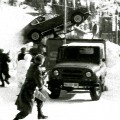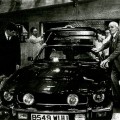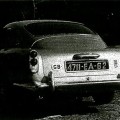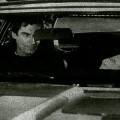-
 The Car That Came in from the Cold.
The Car That Came in from the Cold.Our reporter, on hand during the filming of the latest James Bond movie, explains how 007 is back behind the wheel of an Aston again
Autoweek
James “shaken but not stirred” Bond prefers, as all 007 followers should know, Aston Martins. Granted, the famous secret agent has been seen at the wheel of other British marques, notably a Lotus Esprit Turbo in The Spy Who Loved Me, but for most people his best remembered car is an Aston. And it was with this in mind that the producers of the latest Bond movie, The Living Daylights, made a late-in-the-day change in James’ choice of transport.
The Living Daylights asks a lot of Bond aficionados; it introduces a new James Bond (Timothy Dalton), a new Miss Moneypenny, and a less sexually charged atmosphere, so it was felt that at least 007’s wheels should maintain a strong link to the past. Nothing is more evocative and symbolic of the Bond films’ glory days than the Aston Martin DB5 Sean Connery drove in Goldfinger and Thunderball, made more than 20 years ago. The famous sports car, which discharged gas clouds, sprayed bullets and nails, and spat out oil and even passengers (from an ejector seat), was a special kind of cinematic hero long before Steven Spielberg animated kitchen appliances and peanut butter jars.
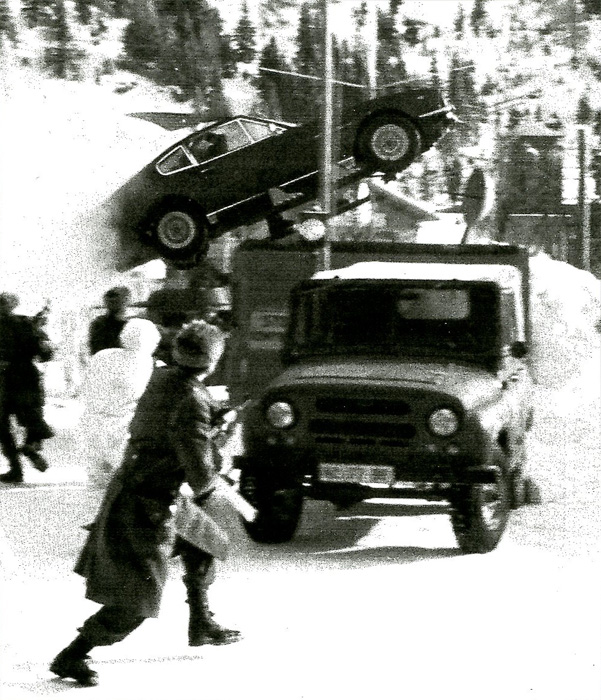
Three secondhand Aston Martin Vantages, and several more fiberglass mock-ups were used in Daylights. Here Bond makes his escape in one of the real cars, equipped with skis.
Following Thunderball’s completion, the original stunt car was sold, along with two exact duplicates, all outfitted by the Aston Martin factory in Newport Pagnell, England. In the intervening years between Thunderball’s release (1965) and the current movie, the original three modified DB5s each changed ownership several times. They continue to fetch handsome prices on the auction block.
Naturally, one would think that the same fate would be in store for the Aston Martin Vantage used in The Living Daylights. The modifications made to the Vantage by Eon Productions Ltd., which creates Bond films, are similar to those carried out on the DB5 – but with a heavy dose of ’80s technology; the car fires missiles, shreds tires with a laser beam, skis, and has rocket propulsion. It also drives away with a very lavish movie which is all the more surprising because the Aston Martin you see in the film doesn’t really exist. Rather, it is an unlikely composite of fiberglass panels, plastic tubes and hoses, insert shots, and long, tedious manhours on the soundstage and backlot of Pinewood Studios, near London, as well as in the editing room. On film, however, the illusion is perfect.
“The car is always the menace,” said John Richardson, the special effects supervisor, during a break from shooting. “Q (the technical wizard in Bond movies) never says anything about what gadgets are on It, so you just assume that it’s fully armed, rather like when Bond carries his briefcase. What the menace is inside — who knows?
“It was only at a very late stage that we decided to go with the Aston Martin,” explained Richardson, “subsequently a scene was written in with the car to get better ‘mileage’ out of it. During the heyday of our original car, Aston Martin had something like 200 cars lying outside unsold,” he recalled. “Nowadays you have to order them, and a Volante (Aston’S convertible Vantage) has an 18 month waiting list. Consequently, we bought three used models, only as they became available; we found them through motor ads in local newspapers, for a very reasonable price. ”
The original Daylights scenario called for Bond to play major scenes, including the chase scene, in a Lada. Albert Broccoli, the Bond films’ producer, felt that 007’s image would suffer profoundly if he had to play big scenes in this proletarian and boxy Russian-built vehicle. He also felt that since Bond is British, and employed by the Bntish secret service, he should use a British car when given those assignments where he can take his car with him. Hence, the scene was rewritten: 007 sees the Volante being “winterized” in Q’s workshop. Subsequently, he asks, “Do you mind if I take it for a spin?” Then, cut to the Aston Martin coupe parked a bit too conspicuously on the humble streets of Bratislava, the Czech City where Bond first meets Daylights‘ striking female protagonist, Kara, played by Maryam d’Abo.
Of the three cars that Eon Productions purchased for the film, the first was sent to Austria immediately to be used In the chase scene on a frozen lake near the Austro-Italian border, and didn’t return for several months. Meanwhile the second car was being fitted with some of the gadgets. “If we’d had the Aston Martin here at the studio from day one, we could have possibly fitted more of the gadgets onto one particular car,” Richardson remarked. He added that the used cars they purchased were all resprayed and refurbished by the factory so that they looked identical, though they weren’t quite brought up to new model status. Since the first one the film unit acquired had a canvas sunroof, similar canvas tops were added to other coupes. Richardson explained that sunroofs can be very handy for lighting certain interior shots.
He also revealed the roles of the various Aston Martins scattered about the cavernous soundstage in varying states of degradation. The one most intact was, said Richardson, “what we call the No. 1 car for basic driving, run-bys on the road with Timothy driving it. Then there’s a No.2 which was the stunt car, and in actual fact took a lot of bashing and isn’t really drivable anymore. It’s the car that hit the ramp at about 75 mph and took off and landed on cardboard boxes. It also drove down the side of a mountain. And we have car No.3,” he elaborated, like one of those supremely well organized mad scientists that Steed and Mrs. Peel always encounter on The Avengers, “that is our special effects car.”
Was that the car being towed behind the soundstage, with hoses wrapped around its fenders?
“Oh no, that’s another kind of car altogether,” Richardson corrected, “these are what we call driving cars. No.3, the special effects model, has missiles that come out of the front spotlights. It also has rocket boosters out the back. The laser is going to be on that car. The beam quite literally is the hubcap, which has a little light that comes on — that’s all it does; then it’s all done optically. We have a total of 11 cars, Aston Martins,” he said proudly. “Only three are real cars, of course, though we do have car No. 10, which was a real body modified to make it look like the same model. It doesn’t have an engine, only brakes and steering. That was used for running down the side of a mountain, then to go between two trees, after which the skis get knocked out.”
If only four of the cars had real-bodies, the implication is that seven were unreal. Indeed, the prop shop at Pinewood manufactured molds to make fiberglass bodies for the cars, under Aston Martin’s supervision. The company only hand-builds four shells a month, each being earmarked for a specific chassis. Even close-up, it was hard to tell the full-size mock-ups from the real metal-bodied cars. The idea of using miniatures was rejected from the beginning, Richardson noted.
Surely the most bizarre license that the art department took when interpreting the sports car’s role in the script was for the “winterizing” scene when Q prepares the Vantage for chilly Bratislava. The car seen by the audience prior to that was a Volante, (which happened to belong to Aston Martin’s chairman, Victor Gauntlett). The most obvious and credible thing to do would have been to create a hardtop shell with a shape similar to the fabric top when raised. Instead, as the scene plays in Q’s workshop, a hardtop panel, shaped like the Vantage’s top, is being lowered by a chain onto the body of the convertible, which has its fabric top tucked away. Insert a shot of a welding gun, and presto, the vehicle has been transformed into the stock coupe.
And how did the Aston Martins, notoriously fussy cars, perform? “Remarkably well” according to Richardson, “I was amazed. We took a chance on not taking an Aston Martin man out to Austria, which I really think would have been the right thing to do. But the cars always started, even in the freezing cold when it took the trucks over an hour to start. The Aston Martins never held up our shooting, anyway.”
Part of the action took place in a field behind the soundstage where a frozen lake had been created with a huge white wall, like a drive-in movie screen, at one end; along its base were rows of evergreen trees. Smoke machines poured out fog as one of the fiberglass cars was being put through its paces. It was a “cutaway” shot, a close-up in which a pair of skis is supposed to pop out from the rocker panels and raise the car like a hydrofoil, off its damaged tires. The technicians were on one side of the vehicle, squatting down on the ice and shivering, while pumping air through a hose which was to make the ski snap out pneumatically in a single swift movement. Instead, the ski tended to extend in a series of two or three jerks. The painstakingly mechanical exercise was repeated until the ski hit the ice smoothly, whereupon cameras rolled. In the film, skillful editing and continuity make it impossible to tell that the insert location was different from the wide shot location.
Will any of the three “real” Aston Martin Vantage coupes ever make it to the auction block? Only if Eon Productions goes into the restoration business. The car that remains most driveable is relatively gadgetfree, and the special effects car, with the rocket booster, is fairly devastated. More likely, Eon will store the three cars should they want to re-use them in another film.
Of course Aston Martin can always dummy up a few Vantages to make them look like the real thing, but alas, the secret is out. MG

